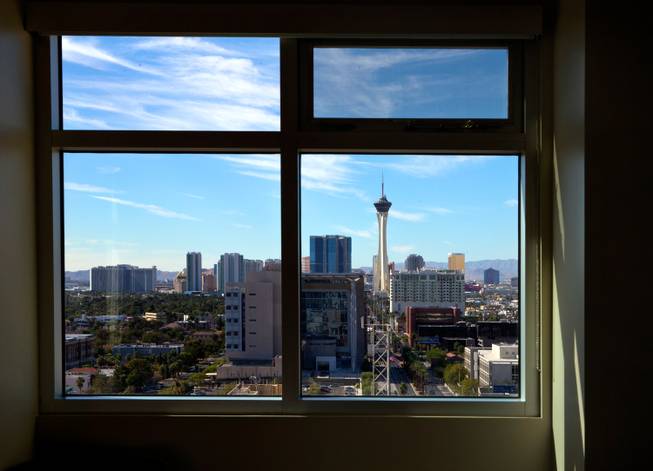
The Ogden, a downtown apartment tower with dynamic views, is being listed as for-sale condos on Wednesday, October 15, 2014.
Thursday, Oct. 1, 2015 | 2 a.m.
Housing in downtown Las Vegas remains a top concern for the city as it takes the next step in crafting a master development plan.
At its core, downtown’s housing issue stems from a lack of affordable mid-range housing, for which city officials believe demand is pent up. The city hopes to encourage developers by attracting amenities to the area. For the downtown to flourish, they say, it needs to not only work as a tourist destination, but also a place for locals to live.
The city will conduct two public outreach meetings to discuss the future of the area Thursday evening. Halfway through its 18-month process, the city is collecting input on housing, street design, open space and transportation, as well as discussing its overarching vision.
The most important question that the city would need to answer, said Taylor Wolak, an architectural designer at Blue Heron, would be how to create “a place to live.” The answer to that question would drive questions about transit, education and amenities: “Where do they work? Where do they go to school? Where do they play?”
“We want to get both sides of that question moving at the same time,” said Robert Summerfield, the city’s project manager for the downtown master plan.
Downtown finds itself in a strange situation. There are roughly 250 acres of vacant lots and about 25 percent of downtown housing units are vacant, according to the city, a rate that is significantly higher than the 8 percent average across the county. The vacancies stem from a lack of demand for pricey high-end apartments or residences in disrepair.
It’s a chicken and egg problem. Better mid-range housing may not be built until urban amenities like grocery stores, movie theaters and retailers are in place. They, in turn, may not show up until housing does. With its downtown master plan, the city, in partnership with private developers, would like to kickstart that cycle.
The Downtown Project, Zappos CEO Tony Hsieh’s $350 million investment to revitalize the urban area surrounding Fremont East, encountered this problem early. It held talks with several supermarket chains, but none came to fruition, leaving The Market as the area's lone major grocery store. Several housing options exist, such as luxury high-rises The Ogden and The Juhl, but are too pricy for the millennials they hope to attract. “We are focused on bridging that gap,” said Mark Rowland, CEO of Downtown Project Ventures.
Rowland hopes to attract a residential developer within the next six months to build at least four 250-unit affordable apartment complexes on land it owns.
The Downtown Project is primarily concerned with developing the stretch around Fremont East. The city’s focus extends far beyond that area, encompassing 11 zones, including the Arts District, the Civic Center District and the Gateway District, an area near the Stratosphere. Currently, only a sliver of the valley’s residents — 45,807 people — live downtown, according to the city. Most of downtown’s residents are under 50 years old.
To break the development stalemate in the city’s core may take public investment, said Tom Perrigo, the city’s director of planning. He cited a plan to build a park on Third Street, which the city has allocated funds to build. “Maybe having a great recreation amenity is enough to start sparking more residential (construction),” Perrigo said.
The Historic Fifth Street School will host Thursday’s public meetings. The first session is scheduled from 2 to 4 p.m. and the second session is 5:30 to 7:30 p.m.
Daniel Rothberg can be reached at 702-259-4185 or twitter.com/danielrothberg

Join the Discussion:
Check this out for a full explanation of our conversion to the LiveFyre commenting system and instructions on how to sign up for an account.
Full comments policy